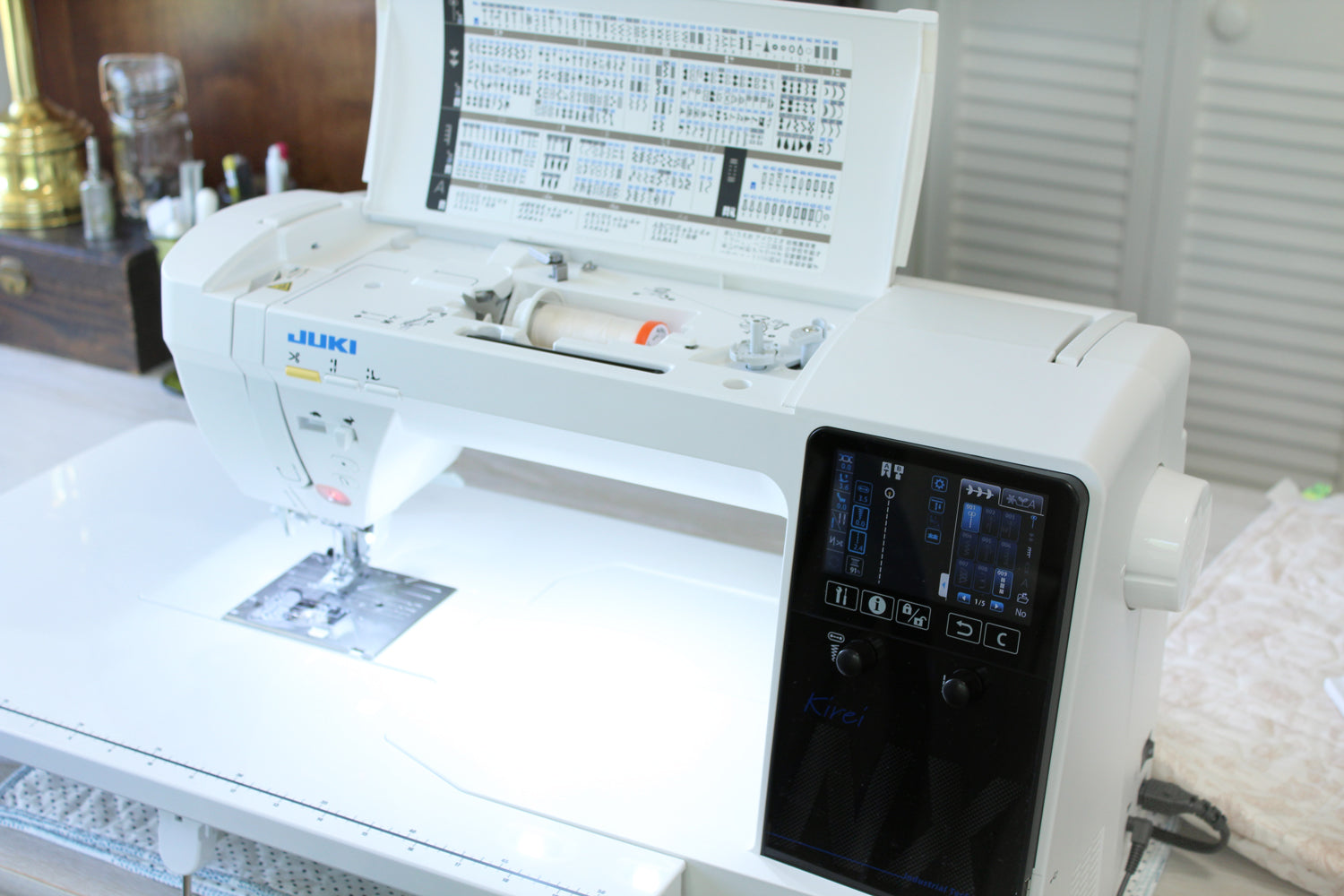August 07, 2025

Last week, I told you how the Juki Kirei ended up in my sewing room. Now let's see what she can do!
TWO MACHINES IN ONE
Besides the main features I was looking for, one of the selling points for me was the ability to basically turn this machine into my old Juki TL2000 without having to hoist and move machines around. That's because it comes with 2 stitch plates and 2 feed dogs.
The one that comes on the machine is a standard stitch plate with a wider hole for zig-zag and specialty stitches, with the needle going side to side. But it also comes with a straight stitch plate (and accompanying feed dog) that is just exactly like my Juki TL2000. When you are piecing little patches of fabric, this makes a big difference in your precision.
It's a little like having two machines, without having to switch machines.

NEEDLE THREADING
Threading the machine is so much easier than my older Juki. Everything is numbered and very intuitive and I haven't fouled it up once. (I swear it must have taken me months to memorize the correct steps to thread my Juki TL2000.) Then, when you get it threaded, it has an amazing needle threader. Really a big upgrade from the one on my older Juki. I got to where I never even used that one. This one works EVERY time.
That little lever on the side there is the needle threader. It walks you through the steps to thread the machine, then you put the thread into the #7 slot, cut the thread (#8) and press that lever (#9). Voila!

PIVOT FEATURE
Another bonus feature is called the Micro Lifter. Basically, you can set the presser foot to raise a little bit whenever you stop sewing. If you're quilting around a shape and come to a corner or a bend, the foot will automatically lift so you can pivot your fabric or quilt. When you start sewing again, it goes back down and off you go! I think this one will make my use of the Knee Lifter very sporadic, since that's what I would use the knee lifter for, mainly. (Sorry for the glare.)

FOOT PEDAL UPGRADE
Another thing I didn't realize I would love so much is being able to program what function the foot pedal uses. On my old Juki TL2000, you used your foot pedal to sew, as usual, but pressing with your heel on the bottom of the foot would trim your threads. It was great, and I used it constantly. But I can't tell you how many times I accidentally cut my threads without meaning to because my heel pressed down.
On the Kirei, the foot pedal just sews. And the extra pedal off to the side does the trimming, or whatever you wish it to do. You can see below where I've got mine selected to trim threads. No more accidental trimming!


ALPHABETS
Some of the bells and whistles include a few alphabets. Honestly, when I was comparing machines I didn't really care about that much. But when I was finishing my little Hexi Quilt, I realized I could put a date in the corner - in thread - faster than I could thread a needle.
I'm not great at remembering to label all my quilts. Probably about half and half, if I'm honest. But I can totally see adding my initials and a date to the corner or the back of a quilt with these alphabets. Complete bonus!


BOBBIN WINDER
The bobbin winder runs on a separate motor and it's very quiet and fast. I will say, I did get the thread wound up beneath the bobbin once and it was a complete pain to get it unwound and untangled. Now I'm a little careful when I start the bobbin winder to make sure it's actually going onto the bobbin.
I do love that you just push the winder toward the bobbin and it starts and finishes automatically. And then you can tell your machine you have a full bobbin and it'll keep track of how much thread is left on the bobbin for you.

STITCH SELECTION
I love how easy the stitch selection menus are to use. I also like the fact that the machine automatically grays out stitches you can't use when the Straight Stitch Plate is on the machine. (You can see only some of the stitches are highlighted in the photo below.) It will only let you select stitches that will work with the straight stitch. It will also tell you which foot to use for the stitch you select.

SMART FEED
Another big selling point for me was the built in walking foot that comes on this machine. It's great for quilting, of course. But I also love it when I'm using a slippery fabric, like rayon or cotton voile to make garments.
I will say that my old Juki had a knob to control the pressure of your presser foot, which I learned to love and use a lot. This machine has that ability too, and it's very convenient to change that setting depending on what your sewing.
The Smart Feed is the white gizmo I've circled. When you want to use it, you just pull it down and snap it in place.

Here's a blurry photo of the Accessory box that comes with it:

I also really like that the top of the machine closes, which makes it easy to dust. I've never kept a cover on my active sewing machine, so I was constantly dusting my Juki TL2000 and all around it's knobs and thread holders. This one has a lot more flat surfaces which equals easier cleaning to me.

I'm Robin, the designer behind October House. You've found my journal, where I talk about stitching, sewing and anything else that might catch my fancy!
Make something beautiful today!

"My best friend is a person who will give me a book I have not read." - Abraham Lincoln



